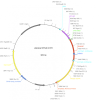Lab Techniques
High-Throughput Screening

Our lab uses a novel system for high-throughput screening of protein degradation in the cell. Instead of relying on the cumbersome method of radiolabeling, cycloheximide treatment, and Western blotting, we utilize photoconvertible fluorescent reporters and a custom-engineered LED array. After protein is photoconverted in live cells via LED illumination, the extinction of fluorescent signal is detected over time either by plate reader, flow cytometry, or microscopy.
Flow Cytometry

Flow cytometry is an incredibly powerful method of single-cell analysis capable of recording 6 logs of fluorescence intensity of up to 12 different colors, with up to millions of cells per sample. Our lab uses flow cytometry for phenotyping of immune cells as well as quantitation of protein degradation. In Biochemistry, we have access to state-of-the-art flow cytometers including a BD Celesta as well as the BD Aria sorter. Training is typically organized through the Biochemistry Cell Culture Facility.
Global Proteomics Via Mass Spectrometry

Global proteomics is the method by which the entire proteome of a sample (tissues, cells, or even subcellular fractions) is identified and quantified. This highly technical method is used by our laboratory to determine the global effects of proteome disruption in cancer and neurodegenerative disease, which provides a huge advantage when studying UBQLN biology. Proteomics is performed by the Mass Spectrometry Facility at the JSCBB.
Molecular Biology

We use the method of ‘Gibson cloning’ to generate all of our constructs for a variety of projects in the laboratory. This allows us to rapidly generate panels of genes for straightforward insertion into standardized vector backbones. Constructs generated in the lab are used for lentiviral stable transfection of cell lines and transient transfection of cells.
Biochemistry & Cell Biology

As a biochemistry lab, we use many advanced biochemical and cell biological methods to understand protein homeostasis including quantitative Western blotting with dual-color fluorescence, immunoprecipitation of protein and co-immunoprecipitation (sometimes followed by proteomic analysis), quantitative PCR (QPCR), BCA, and more.
ES & Primary Cell Culture

The proteome changes significantly depending on the cell type being observed, which can significantly influence our results. Our lab uses a variety of cell culture systems, including human ES cells and murine primary cells, to understand how the proteome changes in neurons and in lymphocytes. We differentiate human ESCs which have been genetically modified to lack UBQLN1, UBQLN2, or UBQLN4, into neurons for our studies of how UBQLNs influence neurodegenerative disease. We also obtain primary murine lymphocytes to understand how UBQLN loss influences their proliferation and protein synthesis.
Microscopy

The JSCBB houses the Biofrontiers Advanced Light Microscopy core, which has microscopes capable of confocal microscopy, live cell imaging, and super-resolution microscopy. Paired with our high-throughput protein degradation assay, advanced microscopy lets us identify protein localization effects on degradation rate. Training is run through the core facility.

